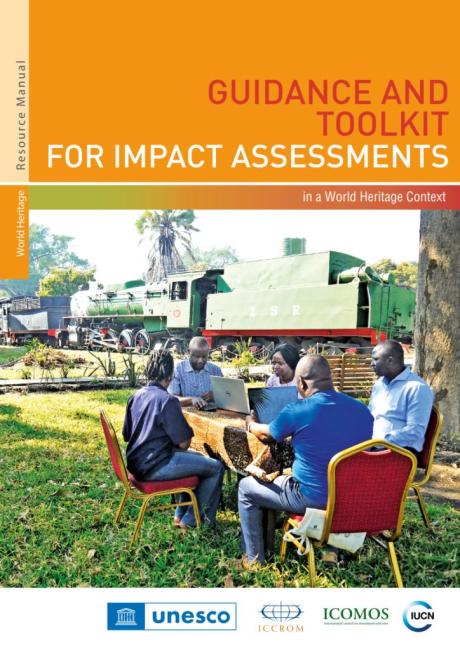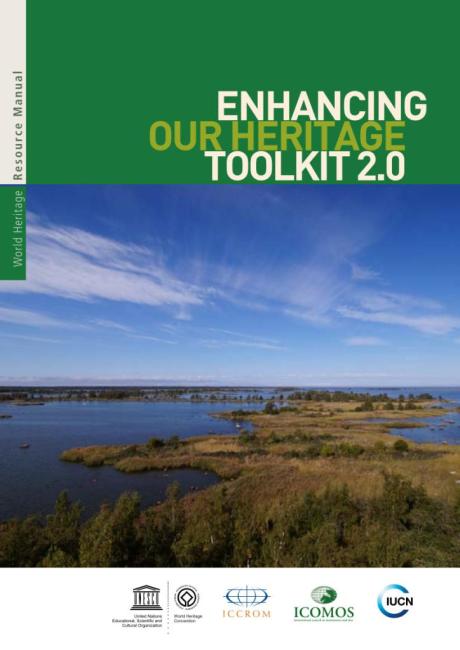Advisory bodies
The three international organizations which are named in the Convention to advise the World Heritage Committee in its deliberations: ICCROM, ICOMOS and IUCN. The
Advisory Bodies
The three international organizations which are named in the
World Heritage Convention
The Convention Concerning the Protection of the World Cultural and Natural Heritage is an international treaty adopted by the UN in 1972 that defines the kind of natural or cultural sites which can be considered for inscription on the World Heritage List for their Outstanding Universal Value for all humankind. Commonly known as the World Heritage Convention, it establishes how the international community as a whole is responsible for
the protection of such heritage and sets out the duties of States Parties in identifying potential sites that may be eligible for inscription onto the World Heritage List and their role in protecting and preserving them. By signing the Convention, each country pledges to conserve not only the sites situated on its territory that have been recognized as being of Outstanding Universal Value, but also to protect its national heritage and to be involved in international efforts to protect, conserve and promote the heritage of humankind.
to advise the World Heritage Committee in its deliberations are ICCROM (International Centre for the Study of the Preservation and Restoration of Cultural Property), ICOMOS (International Council on Monuments and Sites) and IUCN (International Union for Conservation of Nature).
The Advisory Bodies have the following functions:
Advise on the implementation of the
World Heritage Convention
The Convention Concerning the Protection of the World Cultural and Natural Heritage is an international treaty adopted by the UN in 1972 that defines the kind of natural or cultural sites which can be considered for inscription on the World Heritage List for their Outstanding Universal Value for all humankind. Commonly known as the World Heritage Convention, it establishes how the international community as a whole is responsible for
the protection of such heritage and sets out the duties of States Parties in identifying potential sites that may be eligible for inscription onto the World Heritage List and their role in protecting and preserving them. By signing the Convention, each country pledges to conserve not only the sites situated on its territory that have been recognized as being of Outstanding Universal Value, but also to protect its national heritage and to be involved in international efforts to protect, conserve and promote the heritage of humankind.
in the field of their expertise
Provide expert advice on how to conserve and manage properties included on the World Heritage List
Assist the
World Heritage Centre
The UNESCO World Heritage Centre is a technical administrative body within UNESCO, established in 1992 and appointed by the Director-General of UNESCO. It acts as the Secretariat of the
World Heritage Convention
The Convention Concerning the Protection of the World Cultural and Natural Heritage is an international treaty adopted by the UN in 1972 that defines the kind of natural or cultural sites which can be considered for inscription on the World Heritage List for their Outstanding Universal Value for all humankind. Commonly known as the World Heritage Convention, it establishes how the international community as a whole is responsible for
the protection of such heritage and sets out the duties of States Parties in identifying potential sites that may be eligible for inscription onto the World Heritage List and their role in protecting and preserving them. By signing the Convention, each country pledges to conserve not only the sites situated on its territory that have been recognized as being of Outstanding Universal Value, but also to protect its national heritage and to be involved in international efforts to protect, conserve and promote the heritage of humankind.
, is the focal point and coordinator within UNESCO for all matters related to World Heritage, and ensures the day-to-day management of the Convention.
in preparing the Committee’s documentation, the agendas of its meetings and in implementing the Committee’s decisions
Assist with the development and implementation of the Global Strategy for a Representative, Balanced and Credible World Heritage List, the World Heritage Capacity Building Strategy, Periodic Reporting, and the strengthening of the effective use of the World Heritage Fund
Monitor the state of conservation of World Heritage properties (including through Reactive Monitoring missions at the request of the Committee and Advisory missions at the invitation of the
States Parties
The countries which have adhered to the Convention Concerning the Protection of the World Cultural and Natural Heritage (
World Heritage Convention
The Convention Concerning the Protection of the World Cultural and Natural Heritage is an international treaty adopted by the UN in 1972 that defines the kind of natural or cultural sites which can be considered for inscription on the World Heritage List for their Outstanding Universal Value for all humankind. Commonly known as the World Heritage Convention, it establishes how the international community as a whole is responsible for
the protection of such heritage and sets out the duties of States Parties in identifying potential sites that may be eligible for inscription onto the World Heritage List and their role in protecting and preserving them. By signing the Convention, each country pledges to conserve not only the sites situated on its territory that have been recognized as being of Outstanding Universal Value, but also to protect its national heritage and to be involved in international efforts to protect, conserve and promote the heritage of humankind.
) (UNESCO, 1972).
)
Review requests for International Assistance
Attend meetings of the World Heritage Committee and the Bureau in an advisory capacity.
The Advisory Bodies are involved in the review of proposed actions and and any related impact assessments when they are requested by the World Heritage Committee.
have the following functions:
- advise on the implementation of the
World Heritage Convention
The Convention Concerning the Protection of the World Cultural and Natural Heritage is an international treaty adopted by the UN in 1972 that defines the kind of natural or cultural sites which can be considered for inscription on the World Heritage List for their Outstanding Universal Value for all humankind. Commonly known as the World Heritage Convention, it establishes how the international community as a whole is responsible for
the protection of such heritage and sets out the duties of States Parties in identifying potential sites that may be eligible for inscription onto the World Heritage List and their role in protecting and preserving them. By signing the Convention, each country pledges to conserve not only the sites situated on its territory that have been recognized as being of Outstanding Universal Value, but also to protect its national heritage and to be involved in international efforts to protect, conserve and promote the heritage of humankind. in the field of their expertise, - assist the Secretariat in preparing the Committee›s documentation, the agenda of its meetings and in implementing the Committee’s decisions,
- assist with the development and implementation of the Global Strategy for a Representative, Balanced and Credible World Heritage List, the World Heritage Capacity Building Strategy, Periodic Reporting, and the strengthening of the effective use of the World Heritage Fund,
- monitor the state of conservation of World Heritage properties (including through Reactive Monitoring missions at the request of the Committee and Advisory missions at the invitation of the
States Parties
The countries which have adhered to the Convention Concerning the Protection of the World Cultural and Natural Heritage (
World Heritage Convention
The Convention Concerning the Protection of the World Cultural and Natural Heritage is an international treaty adopted by the UN in 1972 that defines the kind of natural or cultural sites which can be considered for inscription on the World Heritage List for their Outstanding Universal Value for all humankind. Commonly known as the World Heritage Convention, it establishes how the international community as a whole is responsible for
the protection of such heritage and sets out the duties of States Parties in identifying potential sites that may be eligible for inscription onto the World Heritage List and their role in protecting and preserving them. By signing the Convention, each country pledges to conserve not only the sites situated on its territory that have been recognized as being of Outstanding Universal Value, but also to protect its national heritage and to be involved in international efforts to protect, conserve and promote the heritage of humankind. ) (UNESCO, 1972). ), - review requests for International Assistance and attend meetings of the World Heritage Committee and the Bureau in an advisory capacity.
ICOMOS and IUCN are responsible for evaluating properties nominated for inscription on the World Heritage List, in consultation and dialogue with nominating
States Parties
The countries which have adhered to the Convention Concerning the Protection of the World Cultural and Natural Heritage (
World Heritage Convention
The Convention Concerning the Protection of the World Cultural and Natural Heritage is an international treaty adopted by the UN in 1972 that defines the kind of natural or cultural sites which can be considered for inscription on the World Heritage List for their Outstanding Universal Value for all humankind. Commonly known as the World Heritage Convention, it establishes how the international community as a whole is responsible for
the protection of such heritage and sets out the duties of States Parties in identifying potential sites that may be eligible for inscription onto the World Heritage List and their role in protecting and preserving them. By signing the Convention, each country pledges to conserve not only the sites situated on its territory that have been recognized as being of Outstanding Universal Value, but also to protect its national heritage and to be involved in international efforts to protect, conserve and promote the heritage of humankind.
) (UNESCO, 1972).
, and present evaluation reports to the Committee. ICOMOS examines properties nominated under criteria from (i) to (vi), IUCN of properties nominated under criteria from (vii) to (x), whilst both organisations evaluate properties nominated under a combination of criteria including at least one among (i) to (vi) and one among (vii) to (x). ICCROM provides expert advice on how to conserve and manage listed properties, and it offers a variety of capacity building opportunities to professionals charged with their care.



